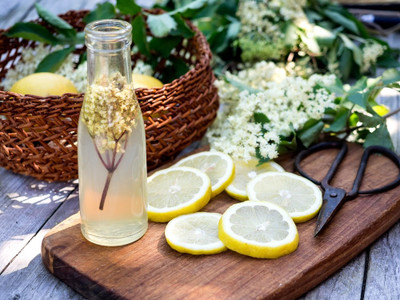Discovering Elderflower Champagne
Posted by The Wares Team on 21st Jun 2020
If you’re fed up of lockdown now and craving a time when you can meet up
with friends and family without any restrictions on numbers, you’re not
alone. Maybe you have a big celebration date coming up, such as a
wedding, engagement, anniversary or a ‘big’ birthday, or perhaps that
date has passed and you’ve had to postpone it for the time being. If all
of this sounds familiar, then it might help to spend some time planning
that celebration day, and even preparing some things in advance.
It might seem strange to do this, but actually focusing on something
tangible and real could lift your mood and make you feel a little bit
better about having to miss out on seeing all of your friends and loved
ones for so long. In today’s blog post, we’re going to look at something
really rather special that you can make right now - and if you can bear
to leave it until your celebration day, you’ll soon be hooked on making
it every year. We’re talking about elderflower champagne; an easy to
make drink that will really impress you.
Get your glass bottles ready
Before you get started on making some elderflower champagne, it’s worth
talking about the bottles that you’ll use to store the champagne.
Because this will be a fizzy champagne with a bit of a kick to it, just
like real champagne, you need to ensure that your bottles are strong and
have a secure means of stopping them up. Clip-top bottles are ideal for
this purpose.
Don’t be tempted to re-use old bottles with plastic lids as you could
find you have a small explosion on your hands if the fizz is a little
bit too much! Check out our extensive range of glass bottles to ensure
that you are well-stocked before you start to make your elderflower
champagne. With fast delivery, any bottles you buy should be with you by
the time you’re ready to move your champagne from your fermenting
bucket and into the bottles.
What else do you need for elderflower champagne?
As mentioned above, you will need a couple of large fermenting buckets
with lids, preferably with airlocks too. You’ll also need some muslin
for straining your champagne after the fermentation stage, and a sachet
of dry champagne yeast. If your local shops are not yet open or you are
self-isolating or shielding, these items are readily available online.
In terms of actual ingredients, you will need 2kg sugar, 8 unwaxed
lemons and of course, the all-important elderflower heads. You’ll need
around 20 large heads for this recipe, and you should try to pick them
early in the morning when they are dry. Don’t pick heads that are
already going over, or heads that have not yet come out in flower.
The elderflower champagne method
Before you start, make sure that one fermenting bucket has been properly
sterilised - the easiest way to do this is to use Campden tablets. Once
sterilised, add the sugar to the bucket and then pour in 5 litres of
boiled water. Stir to fully dissolve the sugar, and then add a further 5
litres of cold water.
Shake the elderflower heads vigorously to get rid of bugs, but don’t
wash them. Then use a fork to strip off the elderflower flowers from the
stalks. When the water has cooled slightly, add the elderflowers and
the zest and juice of the lemons, with the sachet of yeast (this should
be 5gms). If your bucket has an airlock, put the lid on firmly, but if
it doesn’t have an airlock, just rest the lid on the top of the bucket.
Leave in a cool place for six days, to allow the fermentation process to
complete.
After six days, boil your muslin to sterilise it, and sterilise the
second fermenting bucket. Then strain the elderflower champagne through
the muslin into the second bucket, leaving behind as much sediment as
possible. Allow the bucket to stand for a few hours to let any remaining
sediment settle.
Siphon the elderflower champagne into clean, sterilised glass bottles
and seal. Leave in a cool, dark place for 5 days and then open the
bottles to check the fizz levels and let out any CO2 build-up. If the
champagne seems particularly fizzy, it’s wise to store it in the fridge
to slow down any further fermentation and CO2 build-up. Remember -
always use bottles that are designed for fizzy drinks, to avoid
unfortunate accidents!
We hope we’ve inspired you to make some elderflower champagne.
Elderflowers are abundant right now in hedgerows and gardens, and are
easy to identify. Check online or ask for advice if you’re unsure, of
course. And if you have access to plenty of elderflowers, why not make a
batch of elderflower gin too, as well as good old-fashioned elderflower
cordial? Be sure to share your photos and stories with us on Facebook,
Instagram and Twitter - we love to see your preserving projects!

